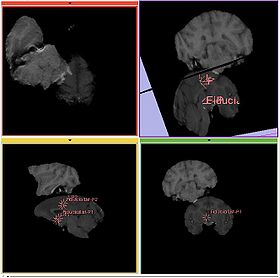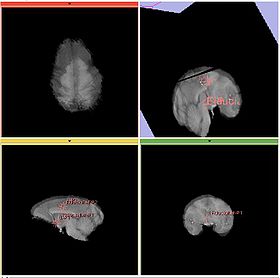Modules:TransformFromFiducials-Documentation-3.6
Return to Slicer 3.6 Documentation
Transform From Fiducials
Transform From Fiducials
General Information
Module Type & Category
Type: CLI
Category: Registration
Authors, Collaborators & Contact
- Author1: Casey Goodlett, Kitware
- Contributor1: Dominik Meier, BWH
- Contact: Casey Goodlett
Module Description
This module computs a linear transform from two lists of fiducials. The transform can either be translation only, rigid transform, or similarity transform.
Usage
The user must create two lists of fiducials with the ordering of the two lists implying correspondence. That is point 1 of list 1 goes with point 1 of list 2. Note that only points which are considered selected in the fiducials model are included. For rigid and similarity transforms, the user must specify at least three points in each list.
Examples, Use Cases & Tutorials
- Use case 1: Registration initialization. If the user can specify a few anatomical points (at least 3), this module can be used to generate a transform which can be used to initialize image based registration.
- IGT tasks that generate landmarks from a tracker automatically can use this module to compute transforms.
Quick Tour of Features and Use
- Main panel:
- Fixed landmarks - target list of points. The resulting transform maps an object onto the fixed landmarks.
- Moving landmarks - source list of points. The result transform maps objects from this space to the fixed landmark space.
- Save Transform - Transform node to save the result in. Typically a new transform should be created.
- Transform Type
- Translation - The resulting transform is the translation vector between the centroid of the moving landmarks to the centroid of the fixed landmarks.
- Rigid - The resulting transform is the rigid transform that best moves the moving landmarks to the fixed landmarks in a least squares sense. The translation component is identical to the translation produced by translation alone.
- Similarity - The resulting transform is the rigid transform that best moves the moving landmarks to the fixed landmarks in a least squares sense. The translation component is identical to the translation produced by translation alone and the rotation is equivalent to that from the rigid transform. This uses the symmetric formulation of computing the scaling factory given by Horn 1987, see reference below.
Development
This module is based on itk::LandmarkBasedTransformInitializer. Additional code is internally used in the module to compute the scaling factor for similarity transforms. This code is based on (Horn 1987).
Known bugs
Follow this link to the Slicer3 bug tracker.
Usability issues
Follow this link to the Slicer3 bug tracker. Please select the usability issue category when browsing or contributing.
Source code & documentation
Source code:
Acknowledgment
This work is part of the National Alliance for Medical Image Computing (NAMIC), funded by the National Institutes of Health through the NIH Roadmap for Medical Research, Grant U54 EB005149. Information on the National Centers for Biomedical Computing can be obtained from National Centers for Biomedical Computing.
References
Berthold K. P. Horn (1987), "Closed-form solution of absolute orientation using unit quaternions," Journal of the Optical Society of America A, 4:629-642

